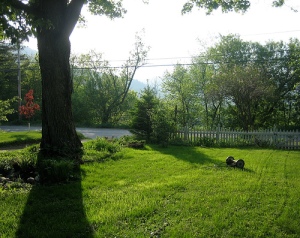About this time of year, we’ve had enough of winter and are anxious to start gardening and working on the lawn. There are lots of creative options for lawns and now is the time to start planning.
Though conventional lawns are a perfect medium where kids can play as well as provide a nice, kempt look to your landscape, to get that perfect, weed-free golf course look requires time, expense and unnecessary chemicals and nitrogen-based fertilizers. Many of these chemicals are known carcinogens and linked to health problems in children, pets and adults. These chemicals get tracked into our home, seep into our waterways and kill beneficial life in the soil.
Turf grass is our largest irrigated “crop” using as much as half of all fresh water used in urban areas each year. With drought striking much of the country, this is an awful waste of water. Lawns also use 20 times more pesticides per acre than farms. Additionally, the fuel used to power mowers and other fume-belching equipment required to maintain a perfect lawn emits toxic emissions into the air.
You can have a beautiful, lush, green lawn where your kids and pets can safely play without the use of chemicals and save money too. How?
- Feed your grass naturally with organic fertilizers available at your local nursery.
- Spread a thin layer of compost over the turf, particularly on the trouble spots. The beneficial bacteria in the compost wake up your turf miraculously!
- Throw down some extra seed.
- Add plenty of calcium to your turf.
- Leave your grass clippings, a natural source of nitrogen, after you mow. Cornell researchers have shown that mulching leaves on to the lawn in the fall results in faster green up in the spring.
- Mow high. Longer grass encourages longer roots, which require less water and food.
- When you water, water deeply and infrequently.
- Learn to live with a few weeds, or wild herbs. Dandelions actually add a bit of color, don’t last long, and in fact are a highly nutritious, edible weed (only on an organic lawn however). Monocultures like a lawn are not typical in nature and only invite problems.
Alternatives to Conventional Lawns
- Edible Landscapes with sustainable, self-perpetuating vegetables, herbs, fruits and nuts. There are edible landscape companies available to consult and/or install.
- Wildflower and perennial gardens that attract beneficial bees and butterflies.
- Cool season or warm season ornamental, drought-tolerant grasses that need no mowing.
- Low maintenance ground covers like myrtle or nitrogen-enriching clover that stays green even in the driest part of the summer.
- Trees and shrubs
- Xeriscapes, or landscapes with an emphasis on water conservation, soil improvement, limited turf, native plants, proper mulching and low-maintenance
- Or a combination of the above
This spring, take a safer and healthier approach to lawn maintenance!
Some information compiled from: http://eartheasy.com/grow_lawn_alternatives.htm#c. www.ediblelandscapes.net, and http://www.bostontreepreervation.com.
For more green living tips, visit greenwithbetsy.com.
